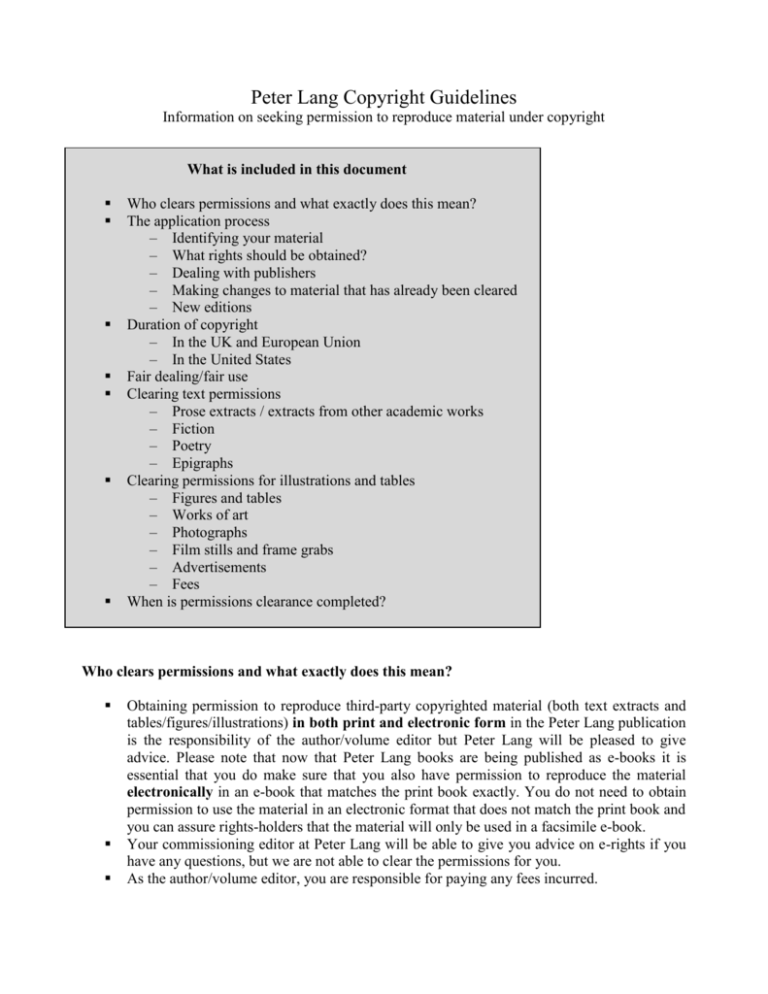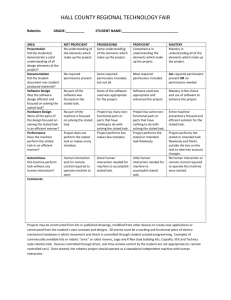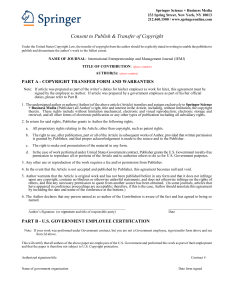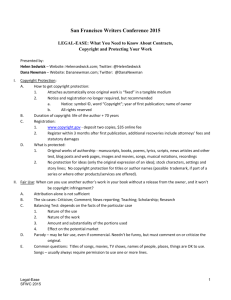Peter Lang Copyright Guidelines
advertisement

Peter Lang Copyright Guidelines Information on seeking permission to reproduce material under copyright What is included in this document Who clears permissions and what exactly does this mean? The application process – Identifying your material – What rights should be obtained? – Dealing with publishers – Making changes to material that has already been cleared – New editions Duration of copyright – In the UK and European Union – In the United States Fair dealing/fair use Clearing text permissions – Prose extracts / extracts from other academic works – Fiction – Poetry – Epigraphs Clearing permissions for illustrations and tables – Figures and tables – Works of art – Photographs – Film stills and frame grabs – Advertisements – Fees When is permissions clearance completed? Who clears permissions and what exactly does this mean? Obtaining permission to reproduce third-party copyrighted material (both text extracts and tables/figures/illustrations) in both print and electronic form in the Peter Lang publication is the responsibility of the author/volume editor but Peter Lang will be pleased to give advice. Please note that now that Peter Lang books are being published as e-books it is essential that you do make sure that you also have permission to reproduce the material electronically in an e-book that matches the print book exactly. You do not need to obtain permission to use the material in an electronic format that does not match the print book and you can assure rights-holders that the material will only be used in a facsimile e-book. Your commissioning editor at Peter Lang will be able to give you advice on e-rights if you have any questions, but we are not able to clear the permissions for you. As the author/volume editor, you are responsible for paying any fees incurred. The application process Identifying your material A clear numbering system is essential to keep track of permissions during the application process if you are applying to use a lot of material. What rights should be obtained? In most cases you will need to secure non-exclusive world English-language rights (including the United States), for both print and electronic (facsimile e-book) form. Dealing with publishers Most publishers charge a minimum fee to offset the cost of processing small permissions fees, or set a minimum number of words or figures below which no fee is charged. The publisher, either as owner of the copyright or on behalf of the author where copyright remains with him/her, has exclusive right to grant (or withhold) permission, and demand any fee they think reasonable. They also have the right to specify both the position and the wording of the acknowledgement. Please note that even if your use constitutes fair dealing, you should give proper credit to the original source. You should, in the first instance, contact the publisher for permission to use material previously published by them. Some publishers may then request that you contact the author of the work to seek their permission directly. You need to make all reasonable efforts to track down the copyright owner and get them to reply. This may be complicated if rights have moved from one publisher to another or have reverted to the author. It‘s important therefore for you to keep a record of all your correspondence, as proof that you have attempted to gain permission to use the material Making changes to material that has already been cleared Once you have received permission for material, any changes to content (e.g. fresh excerpting) normally mean that the piece has to be re-cleared. It is quite possible the copyright owner will not like the new proposed alterations and they are entitled to refuse permission. New editions Note that permissions secured for text or figures in a previous edition of any book are not normally transferable to future editions of that book. So you usually have to start the permissions clearance from scratch for each new edition Duration of copyright In the UK and European Union Where the author holds copyright, the term of copyright protection lasts for 70 years from the end of the year in which the author died. Where the publisher holds copyright the term is also 70 years, but after the end of the year of first publication. After that date, the work will be in the public domain, and can be reproduced without permission. If the work is of unknown authorship, copyright still expires at the end of the period of 70 years from the end of the first year of publication. In the United States For works first published on or after 1 January 1978 copyright protection lasts for 70 years from the end of the year in which the author died For works published before 1978 US copyright law is rather complicated. As a rough guideline: – Works published prior to 1 January 1964 were required to have copyright renewed during the twenty-eighth year of their first term to receive the full period of protection, which now endures for 95 years from first publication. – Works published between 1 January 1964 and 31 December 1977 are protected for 95 years without the need for renewal. – Copyrights in their second term of protection on 1 January 1978 automatically received the full 95-year period without requiring renewal. If you are unsure whether copyright was renewed for the material you wish to use, you should contact the Library of Congress Copyright Office, 101 Independence Avenue, SE Washington DC, 20559-6000, United States, www.loc.gov/copyright. Fair dealing/fair use In the UK and European Union, if you are quoting for purposes of ‘criticism or review’, i.e. your text is clearly the primary text in all instances, or if you are reporting on current events, the ‘fair dealing’ rule enables you to quote more freely. Note that the 1988 UK Copyright Act does not actually specify how much copyright work can be reproduced without permission. Instead it refers to the concept of a ‘substantial’ part. However, for practical purposes working guidelines are in use across the industry. Please refer to the information on prose extracts and poetry (below) for details of the conventional limits on what you can use under fair dealing. In the US, the ‘fair use’ convention is generally taken as allowing one to quote up to a total of 400 words from a book, or 50 words or less from an article or chapter in an anthology. Clearing text permissions (for both print and e-book use) The copyright holder will require the following information in order to process your application: – original chapter/article title – original book/journal name and number – original page numbers – publisher – year of publication Prose extracts / extracts from other academic works As a guide, you are advised to seek permission to use extracts from copyright material if you wish to reproduce: – a single extract of more than 400 words – a series of extracts from one publication totaling more than 800 words, of which any one extract is more than 300 words Obtaining permission to use an article from its publisher will not encompass any ‘thirdparty’ copyright material (e.g. an illustration) that was, or should have been, cleared for the original publication. You must either delete this material or clear it separately. Fiction Recently translated or edited editions may seem preferable, but often incur higher fees for their use. Ask yourself whether there is a suitable older version in the public domain that would not require permission. If your photocopy is from a version of a public domain text subsequently modified or annotated, be aware that this might still be in copyright and will therefore require permission. Poetry The fair dealing guidelines for using poetry are different from those covering prose. For poetry they permit use of small amounts of material ‘for the purposes of criticism and review’, with ‘review’ considered to cover material used to support an academic argument. Generally, poetry would not be considered as being used for criticism and review unless it is in a literature book. The conventional limit is up to 40 lines from a poem providing that this amounts to no more than one quarter of the poem. So, if you wish to use more than one quarter you must clear permission. As a general rule, reproducing the work of famous poets, even in very small quantities, is often difficult and expensive. This applies also to song lyrics. The 1988 UK Copyright Act encourages permission to be sought when a ‘substantial’ amount of material is used. However, this concept of a substantial part can refer not just to length but also to how recognizable the extract is. Therefore, the copyright holder of a famous poem or song may require use of a single line to be cleared. Epigraphs The general rule for epigraphs is that they need to be cleared regardless of length because, unless they are being used for the purposes of criticism or review (which they can be if you then discuss them in the chapter), they do not fall under the fair dealing rule. As a guideline you should ask yourself whether the quotation simply ‘prettifies’ rather than supports the academic argument. If the former you will need to clear permission. Clearing permissions for illustrations and tables (for both print and e-book use) Figures and tables You will need permission if: – you intend to use a direct copy of any photograph, line drawing or table that has been previously published in another source. – you intend to adapt a line drawing or a table that has been previously published in another source. You do not need permission if: – you intend to use raw data to construct a figure, illustration or table (although the source of the data must be credited). Works of art To reproduce the image of a work of art, you need to source a photograph of it and picture libraries etc/. may charge you for a high-resolution image, but that does not necessarily mean that you have secured permission to use this image in your publication. If it is a painting that you want, you to need to find out who owns the copyright, in order to apply for permission from the correct source: – if the artist died more than 70 years ago, the painting will be in the public domain. – if the artist died less than 70 years ago, or is still alive, you will need to ask permission of either the painter or the painter’s estate (most twentieth-century artists are still in copyright). – if the painting is owned by someone privately or a gallery, you may need to ask permission of the owner (the law is different in different countries). In each of the above instances you will also need to establish: – if the photographer owns the copyright in the photograph. If so, you'll also need to apply for permission from the photographer. You should be aware that you may need to pay a reproduction fee to the owner and a copyright fee to the artist; this can prove very expensive. For most fine art it is cheaper to approach museums and galleries direct, rather than contacting a commercial art picture library. Photographs and permission for contemporary artists can usually be obtained through their dealer or gallery. Search on the internet for details or try www.artincontext.com. Artists’ copyright can be cleared through the following organizations: – United Kingdom: Design and Artists Copyright Society (DACS), Parchment House, 13 Northburgh Street, London EC1V 0JP, United Kingdom, Tel: +44 (0) 20 7336 8811, Fax: +44 (0) 20 7336 8822, www.dacs.co.uk, email: info@dacs.org.uk. – United States: Artists Rights Society (ARS) 536 Broadway, 5th Floor (at Spring Street), New York, NY 10012, United States, Tel: +1 212 420 9160 Fax: +1 212 420 9286, www.arsny.com. – Germany: VG Bild-Kunst, Weberstrasse 61, D-53113 Bonn, Germany, Tel: +49 (0) 228 915 34 0, Fax: +49 (0) 228 915 34 39, info@bildkunst.de, www.bildkunst.de. – Switzerland: ProLitteris, Postfach, 8033 Zürich, Switzerland, Tel: +41 (043) 300 66 15, Fax: +41 (043) 300 66 68, mail@prolitteris.ch, www.prolitteris.ch. Photographs Unless otherwise stated, you should apply to the publisher for permission to reproduce a photograph. However, in some instances, copyright may reside with the photographer. The source of the photograph should be given in the figure caption or in the acknowledgements, and it is to this source that you should apply for permission. You will need permission before using a photograph from a picture agency. You must be aware of the owner’s moral right of integrity in illustrations. This can be infringed by: – cropping photographs – changing colours in artwork If you want to use a photograph you have taken of someone, you should seek permission from them. If they object to the context of the photos, then you are technically in breach of copyright (this comes under the moral right to privacy). Film stills and frame grabs If film stills are obtained or frame grabs taken for the purposes of criticism or review their use will be considered fair dealing if accompanied by a ‘sufficient acknowledgement’. In order for the use to be fair, it is advisable that you use only a reasonable number of images from any one film and that, in the case of each individual film, the examples used should not form more than an insignificant proportion of the book. The acknowledgement must give the film’s name together with the name of its producer. In addition, for films made on or after 1 July 1994, it must also give the name of the film’s principal director. If there is any doubt about whether your use constitutes fair dealing please contact the indicated copyright holder. Advertisements Advertisements are not covered by the fair dealing law, so permission has to be cleared in all instances Companies usually give permission with no fee because, in effect, using their advertisements gives them additional advertising. It is always worth sending the accompanying text along with the permission request to reassure the company that you are not saying anything negative about the advertisement Fees Print fees tend to be charged by museums, galleries and similar public sources. These fees are payable whether the illustration is published or not, and mean that you have bought a copy of the image (though not the rights). Hire fees are usually charged by commercial photo libraries and museums for the loan of colour material, but occasionally for black and white too, and they are payable whether or not the material is used. Search fees are charged by many commercial picture libraries for researching and supplying material at your request. Reproduction fees, for example those charged by photo libraries, are paid only if the illustration is reproduced, and if possible you should arrange to pay these fees on publication. Explaining that the book is an academic book, with a small print run, may well help reduce the fee Copyright fees may be charged by the publisher for use of the material if the work of art or photograph is still in copyright When is permissions clearance completed? Although you should make every effort to clear copyright, there are occasions when a book must go to press, despite the fact that some permission requests have not been answered. In this case you should insert a standard disclaimer at the beginning or end of your list of acknowledgements: Every effort has been made to trace copyright holders and to obtain their permission for the use of copyright material. The publisher apologizes for any errors or omissions in the above list and would be grateful for notification of any corrections that should be incorporated in future reprints or editions of this book.







